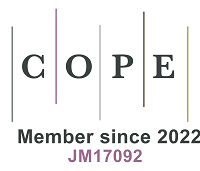REFERENCES
1. UNECE. Protocol on persistent organic pollutants under the 1979 convention on long-range transport air pollution. Available from: https://unece.org/sites/default/files/2021-10/1998.POPs_.e.pdf [Last accessed on 19 Jan 2022].
2. UNECE. Preparation of an internationally binding instrument for implementing international action on certain persistent organic pollutants. Available from: http://chm.pops.int/Portals/0/docs/from_old_website/documents/meetings/ceg2/en/ceg2inf2e.html [Last accessed on 19 Jan 2022].
3. Vallack HW, Bakker DJ, Brandt I, et al. Controlling persistent organic pollutants–what next? Environ Toxicol Pharmacol 1998;6:143-75.
4. Beyer A, Mackay D, Matthies M, Wania F, Webster E. Assessing long-range transport potential of persistent organic pollutants. Environ Sci Technol 2000;34:699-703.
5. Ockenden WA, Jones KC. Global fractionation of persistent organic pollutants. Progress in Environmental Science 1999;1:119-51.
6. Breivik K, Alcock R, Li YF, Bailey RE, Fiedler H, Pacyna JM. Primary sources of selected POPs: regional and global scale emission inventories. Environ Pollut 2004;128:3-16.
7. Kemmlein S, Hahn O, Jann O. Emissions of organophosphate and brominated flame retardants from selected consumer products and building materials. Atmos Environ 2003;37:5485-93.
8. Lohmann R, Northcott GL, Jones KC. Assessing the contribution of diffuse domestic burning as a source of PCDD/Fs, PCBs, and PAHs to the U.K. Atmosphere. Environ Sci Technol 2000;34:2892-9.
9. Wilford BH, Harner T, Zhu J, Shoeib M, Jones KC. Passive sampling survey of polybrominated diphenyl ether flame retardants in indoor and outdoor air in Ottawa, Canada: implications for sources and exposure. Environ Sci Technol 2004;38:5312-8.
10. Mackay D, Wania F. Transport of contaminants to the arctic: partitioning, processes and models. Sci Total Environ 1995;160-161:25-38. DOI: 10.1016/0048.
11. Schure AF, Larsson P, Agrell C, Boon JP. Atmospheric transport of polybrominated diphenyl ethers and polychlorinated biphenyls to the Baltic Sea. Environ Sci Technol 2004;38:1282-7.
12. Chen JC, Wong YS, Wang TSM, Hong H, Xu L, Zhang L. Environmental fate and chemistry of organic pollutants in the sediment of Xiamen and Victoria Harbours. Mar Pollut Bull 1995;31:229-36.
13. Iwata H, Tanabe S, Sakai N, Tatsukawa R. Distribution of persistent organochlorines in the oceanic air and surface seawater and the role of ocean on their global transport and fate. Environ Sci Technol 1993;27:1080-98.
14. Saliot A, Bigot M, Bouloubassi I, Lipiatou E, Qiu Y, Scribe P. Transport and fate of hydrocarbons in rivers and their estuaries. Partitioning between dissolved and particulate phases: case studies of the Rhône, France, and the Huanghe and the Changjiang, China. Sci Total Environ 1990;97-98:55-68.
15. Lohmann R, Corrigan BP, Howsam M, Jones KC, Ockenden WA. Further developments in the use of semipermeable membrane devices (SPMDs) as passive air samplers for persistent organic pollutants: field application in a spatial survey of PCDD/Fs and PAHs. Environ Sci Technol 2001;35:2576-82.
16. Ockenden WA, Sweetman AJ, Prest HF, Steinnes E, Jones KC. Toward an understanding of the global atmospheric distribution of persistent organic pollutants: the use of semipermeable membrane devices as time-integrated passive samplers. Environ Sci Technol 1998;32:2795-803.
17. Gevao B, Al-Omair A, Sweetman A, et al. Passive sampler-derived air concentrations for polybrominated diphenyl ethers and polycyclic aromatic hydrocarbons in Kuwait. Environ Toxicol Chem 2006;25:1496-502.
18. Harner T, Ikonomou M, Shoeib M, Stern G, Diamond M. Passive air sampling results for polybrominated diphenyl ethers along an urban-rural transect. Organohalogen Compounds 2002;57:33-6.
19. Jaward FM, Farrar NJ, Harner T, Sweetman AJ, Jones KC. Passive air sampling of polycyclic aromatic hydrocarbons and polychlorinated naphthalenes across Europe. Environ Toxicol Chem 2004;23:1355-64.
20. Farrar NJ, Harner T, Shoeib M, Sweetman A, Jones KC. Field deployment of thin film passive air samplers for persistent organic pollutants: a study in the urban atmospheric boundary layer. Environ Sci Technol 2005;39:42-8.
21. Harner T, Farrar NJ, Shoeib M, Jones KC, Gobas FA. Characterization of polymer coated glass as a passive air sampler for persistent organic pollutants. Environ Sci Technol 2003;37:2486-93.
22. Wania F, Shen L, Lei YD, Teixeira C, Muir DCG. Development and calibration of a resin-based passive sampling system for monitoring persistent organic pollutants in the atmosphere. Environ Sci Technol 2003;37:1352-9.
23. Müller JF, Hawker DW, Connell DW, Kömp P, Mclachlan MS. Passive sampling of atmospheric SOCs using tristearin-coated fibreglass sheets. Atmos Environ 2000;34:3525-34.
24. Hellström A, Kylin H, Strachan WM, Jensen S. Distribution of some organochlorine compounds in pine needles from Central and Northern Europe. Environ Pollut 2004;128:29-48.
25. Hwang H, Wade TL, Sericano JL. Concentrations and source characterization of polycyclic aromatic hydrocarbons in pine needles from Korea, Mexico, and United States. Atmos Environ 2003;37:2259-67.
26. Tremolada P, Burnett V, Calamari D, Jones K. A study of the spatial distribution of PCBs in the UK atmosphere using pine needles. Chemosphere 1996;32:2189-203.
27. Gerdol R, Bragazza L, Marchesini R, et al. Use of moss (Tortula muralis Hedw.) for monitoring organic and inorganic air pollution in urban and rural sites in Northern Italy. Atmos Environ 2002;36:4069-75.
28. Lead WA, Steinnes E, Jones KC. Atmospheric deposition of PCBs to moss (Hylocomium splendens) in Norway between 1977 and 1990. Environ Sci Technol 1996;30:524-30.
29. Ockenden WA, Steinnes E, Parker C, Jones KC. Observations on persistent organic pollutants in plants: implications for their use as passive air samplers and for POP cycling. Environ Sci Technol 1998;32:2721-6.
30. Schramm KW. Hair: a matrix for non-invasive biomonitoring of organic chemicals in mammals. Bull Environ Contam Toxicol 1997;59:396-402.
31. Jaspers VL, Voorspoels S, Covaci A, Eens M. Can predatory bird feathers be used as a non-destructive biomonitoring tool of organic pollutants? Biol Lett 2006;2:283-5.
32. Zhang H, Chai Z, Sun H. Human hair as a potential biomonitor for assessing persistent organic pollutants. Environ Int 2007;33:685-93.
33. Iglesias-González A, Hardy EM, Appenzeller BMR. Cumulative exposure to organic pollutants of French children assessed by hair analysis. Environ Int 2020;134:105332.
34. Behrooz R, Poma G, Covaci A. Assessment of persistent organic pollutants in hair samples collected from several Iranian wild cat species. Environ Res 2020;183:109198.
35. Iatrou EI, Tsygankov V, Seryodkin I, et al. Monitoring of environmental persistent organic pollutants in hair samples collected from wild terrestrial mammals of Primorsky Krai, Russia. Environ Sci Pollut Res Int 2019;26:7640-50.
36. Covaci A, Tutudaki M, Tsatsakis AM, Schepens P. Hair analysis: another approach for the assessment of human exposure to selected persistent organochlorine pollutants. Chemosphere 2002;46:413-8.
37. D'Havé H, Covaci A, Scheirs J, Schepens P, Verhagen R, De Coen W. Hair as an indicator of endogenous tissue levels of brominated flame retardants in mammals. Environ Sci Technol 2005;39:6016-20.
38. Altshul L, Covaci A, Hauser R. The relationship between levels of PCBs and pesticides in human hair and blood: preliminary result. Environ Health Perspect 2004;112:1193-9.
39. Covaci A, Schepens P. Chromatographic aspects of the analysis of selected persistent organochlorine pollutants in human hair. Chromatographia 2001;53:S366-71.
40. Dauwe T, Jaspers V, Covaci A, Schepens P, Eens M. Feathers as a nondestructive biomonitor for persistent organic pollutants. Environ Toxicol Chem 2005;24:442-9.
41. Kočan A, Bencko V, Sixl W. Polychlorinated Dibenzo-p-dioxins (PCDDs) and Dibenzofurans (PCDFs) in the hair of people living on municipal refuse dumping sites in Cairo (Egypt). Toxicol Environ Chem 1992;36:33-7.
42. Tirler W, Voto G, Donega M. PCDD/F, PCB and hexachlorobenzene levels in hair. Organohalogen Compd 2001;52:290-2.
43. Gevao B, Al-bahloul M, Al-ghadban AN, et al. Polybrominated diphenyl ethers in indoor air in Kuwait: Implications for human exposure. Atmos Environ 2006;40:1419-26.
44. Gevao B, Boyle EA, Carrasco GG, Ghadban AN, Zafar J, Bahloul M. Spatial and temporal distributions of polycyclic aromatic hydrocarbons in the Northern Arabian Gulf sediments. Mar Pollut Bull 2016;112:218-24.
45. Gevao B, Helaleh M, Udin S, et al. Spatial and temporal distribution of persistent organic pollutants (POPs) in coastal marine sediments in Kuwait. Kuwait Institute for Scientific Research 2008; doi: 10.1016/j.chemosphere.2005.05.030.
46. Covaci A. Determination of brominated flame retardants, with emphasis on polybrominated diphenyl ethers (PBDEs) in environmental and human samples—a review. Environ Int 2003;29:735-56.
47. Jaward FM, Farrar NJ, Harner T, Sweetman AJ, Jones KC. Passive air sampling of PCBs, PBDEs, and organochlorine pesticides across Europe. Environ Sci Technol 2004;38:34-41.
48. Shoeib M, Harner T. Characterization and comparison of three passive air samplers for persistent organic pollutants. Environ Sci Technol 2002;36:4142-51.
49. Gevao B, Al-Bahloul M, Al-Ghadban AN, et al. House dust as a source of human exposure to polybrominated diphenyl ethers in Kuwait. Chemosphere 2006;64:603-8.
50. Sjödin A, Jakobsson E, Kierkegaard A, Marsh G, Sellström U. Gas chromatographic identification and quantification of polybrominated diphenyl ethers in a commercial product, Bromkal 70-5DE. J Chromatogr A 1998;822:83-9.
51. Bruckman P, Wackhe K, Ball M, Lis A, Papke O. . Degassing of PBBDD/PBDF levels from a television set-PBBDD/PBDF levels after a fire in a stock house-two case studies. Skoklester: Workshop on brominated flame retardants; 1998.
52. Ball M, Paepke O, Lis A. . Continuation of studies on formation of polybrominated dioxins and furans during subjecting flame protected plastics and textiles to thermal strain. Partial objective 1. Germany: Federal Environmental Agency; 1991.
53. Toriba A, Kuramae Y, Chetiyanukornkul T, et al. Quantification of polycyclic aromatic hydrocarbons (PAHs) in human hair by HPLC with fluorescence detection: a biological monitoring method to evaluate the exposure to PAHs. Biomed Chromatogr 2003;17:126-32.
54. Gill U, Covaci A, Ryan JJ, Emond A. Determination of persistent organohalogenated pollutants in human hair reference material (BCR 397): an interlaboratory study. Anal Bioanal Chem 2004;380:924-9.
55. Nakao T, Aozasa O, Ohta S, Miyata H. Assessment of human exposure to PCDDs, PCDFs and Co-PCBs using hair as a human pollution indicator sample I: development of analytical method for human hair and evaluation for exposure assessment. Chemosphere 2002;48:885-96.
56. Neuber K, Merkel G, Randow FF. Indoor air pollution by lindane and DDT indicated by head hair samples of children. Toxicol letters 1999;107:189-92.
57. Tsatsakis A, Tutudaki M. Progress in pesticide and POPs hair analysis for the assessment of exposure. Forensic Sci Int 2004;145:195-9.
58. Ostrea EM Jr, Villanueva-Uy E, Bielawski DM, et al. Maternal hair--an appropriate matrix for detecting maternal exposure to pesticides during pregnancy. Environ Res 2006;101:312-22.
59. Oghami T, Nonaka S, Irifune H, et al. A comparative study on polychlorinated biphenyl biphenyls (PCB) and polychlorinated quaterphenyls (PCQ) concentrations in subcuteneous fat tissue blood and hair of patients with Yusho in Nagasaki Perfecture. Fukukoa Acta Medica 1991;82:295-9.
60. Miekeley N, Diascarneiro M, Portodasilveira C. How reliable are human hair reference intervals for trace elements? Sci Total Environ 1998;218:9-17.
61. Steindel SJ, Howanitz PJ. The uncertainty of hair analysis for trace metals. JAMA 2001;285:83-5.







